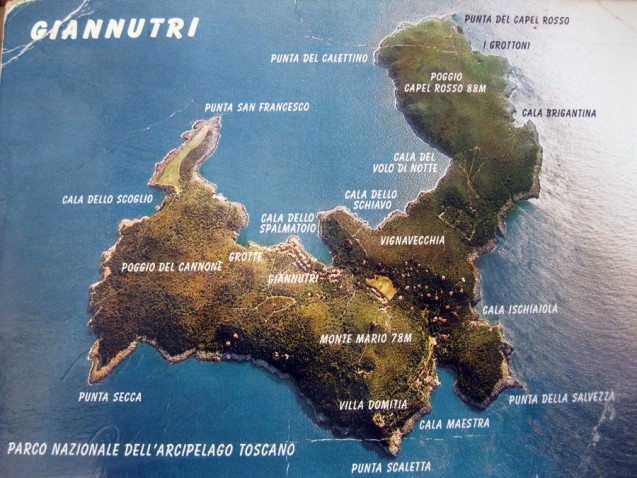Fuori dal mondo – “out of this world” – is what you feel as you step off the ferry onto this tiny Mediterranean island (3 km. long and barely 500 m. wide). The turquoise/emerald water of the island coves is certainly “out-of-this-world” and you are “out of this world” on this island with 180 houses (all reservedly tucked away – we spotted six in our three Giannutri days), fewer than twenty permanent residents, one small piazza with a single restaurant-bar (mostly empty), one meagerly-stocked grocery (usually closed) and only rocky dirt paths leading to the two or three coves of crystalline water. At a fork in the footpaths, the only three signs on the island indicate the swimmable coves and the warning not to verge off the footpaths from early May until late October unless accompanied by an authorized naturalist guide.

Severe regulations preserve the splendid beauty of Giannutri, Parco Nazionale dell’Archipelago Toscano, once a summer island retreat for the Roman patrician Domizi family (Nero’s wife, Agrippina, was a Domizi). Three intricately-sculpted Corinthian capitals, piles of marble once ornamenting the vast baths, stretches of walls now taken over by caper vines, majestic flights of steps and pavements in opus spicatum (“spiked work,”, i.e., herring-bone pattern) are fragmented testament today to the second-century glory of Villa Domizia.
During the summer, the ferry arrives daily from Porto Santo Stefano, with an extra summertime “run” on Friday for weekend vacationers headed to their Giannutri havens. When Pino and I headed to the island home of Roman friends, we asked what we could bring: melons and water. Marina and Angelo met us at the port and we four hauled the eighteen litres of water we’d transported up the dirt path to their cone-shaped tukul plastered in the characteristic rosa antica pink. The tukul – typical house of the island – is a small circular house, windows all around to draw in sea breezes, once with a simple thatched roof: until a roof caught fire in the 1970’s. Now the tukul roofs are tiled.
The Giannutri daily routine is simple: leisurely breakfast on the terrace looking out over the water towards Giglio (you could once see the carcass of the Costa cruise ship laying in the water, like a huge beached white whale), swims, lunch on the terrace (same view – different light), read and/or write, doze or sleep, head to the cove for late swims, back to the house to read/write or chat, aperitif, leisurely dinner as the sun sets over the sea (same view, different light). Only Angelo’s routine might alter a bit: up early to fish and then time to clean and cook the fish for our lunch on the terrace (same view).
Giannutri is not another Capri and has nothing in common with even the lesser-known Mediterreanen islands such as Ischia, Procida, Ponza or Ventotene. If you’re looking for seafood restaurants on the port, outdoor cafes, boutiques, and animated nocturnal piazza life, head for one of those.
On Giannutri, the only disturbing sounds are seabreeze whispers, seagull squawks, the cicadas’ buzz. Those sounds and turquoise-emerald waters are the island’s only offerings.
After all, Giannutri is fuori dal mondo.